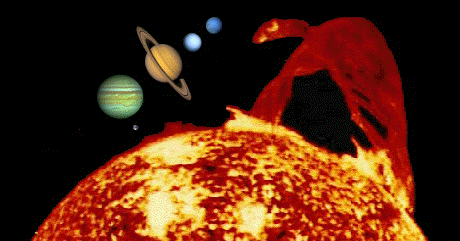
The Sun and the 5 largest planets at a scale of 3200 km/pixel
Build Your Own Scale Model of the Solar System from Scratch!
An activity by Padi Boyd
related to the song:
'Nine Planets'

related to the song:
'Nine Planets'
Measure the circumference of the globe in centimeters, and from this calculate the diameter of your globe. The Earth is 12,740 km in diameter. How much bigger is the actual Earth than the globe? This number is the "scale factor".
C = globe circumference (in cm) = _____________ cm C/pi = globe diameter D = ____________________ cm
D cm = 12,740 km so:
1 cm = 12, 740/D km = 12, 740/______________ km 1 cm = __________________________________ km
This is your scale factor.
Everything on your classroom globe would have to be multiplied by (or scaled by) this number to be the same size as it is on Earth. The same number scales all the oceans and continents on the globe. The Moon's diameter is about 3500 km. Using the same scale factor, have students discuss what common object could represent the Moon. Moon (cm) = Moon (km) / scale factor
= 3500 km / ____________ cm
= ______________________ cm
A softball is usually about right if you're using a standard size globe. The distance of the Moon from the Earth is 400,000 km. Using the same scale factor, ask one student to take a softball the appropriate distance away from the globe. Depending on the size of your room, your Moon student may need to go out in the hallway! Moon's distance(cm) = Moon's distance (km) / scale factor
= 400,000 km / _____________ cm = __________________________ cm
We're going to use the same idea of a scale model for the entire solar system. But in order to fit the entire solar system into a reasonable distance, we'll need a different scale factor, one in which the Earth will be much smaller than the globe. With the new scale factor, we'll be able to walk most, if not all of the solar system, in a class period. The new scale factor is:
Solar system tour scale factor: 1 mm = 2000 km.
|
Object |
D (km) |
D (mm) |
d (km) |
d (m) |
|---|---|---|---|---|
|
Sun |
1,391,900 |
696 |
--- |
--- |
|
Mercury |
4866 |
2.4 |
57,950,000 |
29 |
|
Venus |
12,106 |
6. |
108,110,000 |
54 |
|
Earth |
12,742 |
6.5 |
149,570,000 |
75 |
|
Mars |
6760 |
3.3 |
227,840,000 |
114 |
|
Jupiter |
139,516 |
70 |
778,140,000 |
389 |
|
Saturn |
116,438 |
58 |
1,427,000,000 |
714 |
|
Uranus |
46,940 |
23 |
2,870,300,000 |
1435 |
|
Neptune |
45,432 |
23 |
4,499,900,000 |
2250 |
|
Pluto |
2274 |
1.1 |
5,913,000,000 |
2957 |
In the Table above, D is diameter of the object. The distance of the object from the Sun is d, and is given in meters. This is also the object's orbital radius about the Sun.
Our group used: pepper corn (Mercury), chickpea (Venus), chickpea (Earth), green pea (Mars), large orange (Jupiter), plum (Saturn), cherry tomato (Uranus), cherry tomato (Neptune), coriander seed (Pluto).
Assign one or two students to each object in the solar system. Have them become your local experts on that object. During your solar system walking tour, ask your experts to share their knowledge about their object.
Students should walk away from the solar system tour with a new appreciation for the enormous distances between objects in the solar system, as well as their relative sizes.
At this scale it would be about 2mm across, and 20 cm from the Earth. Likewise, you can include Jupiter's larger moons, the Galilean satellites. Have your Jupiter team research their sizes and distances from Jupiter, and then scale these appropriately.
You can sprinkle grains of salt or sand at 210 meters to represent the asteroid belt, which lies between Mars and Jupiter. But sprinkle very lightly -- the average distance between the larger asteroids is more than ten times the Earth/Moon distance! That's two meters or more on our scale.
You can include Kuiper Belt objects, which are rapidly being discovered near and beyond the orbit of Pluto. Use objects about half the diameter of Pluto and smaller, scattered at roughly the same distance from Neptune, and beyond.